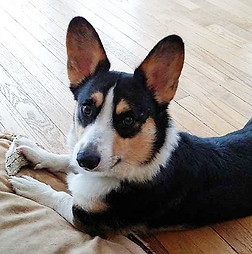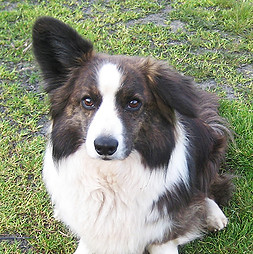
Breed Information

This section is to help in identifying a Cardigan Welsh Corgi, especially in a rescue situation or for a shelter or animal control. Cardigans are much less common than the more populous Pembroke Welsh Corgi. Volunteers find many Cardigans labeled as crosses due to the general public being unaware of the Cardigan as a separate breed. More often than not, Cardigans will be labeled "corgi mix", however, other common descriptions are:Corgi x Cattle Dog, Corgi x Dachshund but we have also seen mention of Collie, Shetland Sheepdog, Catahoula Leopard Dog, Bassett Hound and Australian Shepherd. Please note that in an effort to show the variations in the breed, all of the dogs featured on this page are in fact dogs that have come into rescue or were placed by rescue volunteers. The photo to the right illustrates the size difference between the two breeds. The Cardigan (brindle in foreforont) is substantially larger than the Pembroke (red in back). Pembrokes can also have tails with muddies the waters even further.

Note size difference between this brindle
Cardigan and the red fluff Pembroke.
Here are some things to consider when identifying a Cardigan Welsh Corgi in a shelter or rescue situation:
Body Type
The Cardigan is a long bodied, low to the ground animal. They are of moderate bone structure although some may appear a little lighter in bone than others. Silhouette is similar to that of a fox. Other breeds that are long and low (but less like a fox) are the Bassett Hound or Dachshund, hence the mis-identification. The Cardigan front will appear to have a bow in which the legs wrap around the chest. Chest is usually egg shaped and deep. Fronts will vary greater due to breeding and lifestyle of any given dog. Some dogs may appear very wide while others may seem narrow.
Ears
The Cardigan’s ears are usually very large and upright, offset slightly on the skull, such as the dog pictured to the above. It is also important to mention that not all Cardigan ears “go up” as puppies so it is possible that one may come across a pure bred Cardigan with drop ears. We have seen several drop eared Cardigan over the years in rescue with . Again, body type and structure should further assist one in the process of identification.
Tail
The Cardigan’s tail resembles that of a fox. Although the correct tail set should be low, higher tail sets occur often. Please be aware that tails are sometimes docked, typically seen in dogs from mill situations, as sold as Pembrokes. This is not a normal breed practice but several dogs have come through rescue in this condition and we feel it necessary to mention. Conversely, Pembroke Corgis can also HAVE tails. Pembrokes are often born with tails and are docked at a young age. Usually coat and body style are different though (see prior notes on the Cardigan body type).
Size
Our AKC breed standard states, "...a small, sturdy but powerful dog capable of endurance and speed." The average size of a Cardigan is about 12 inches tall (give or take). Average weight for males is approximately 30-40 pounds. Females average 25-32 pounds. Many of the rescues we see are either very small or extremely overweight. Again, these are averages of a normal healthy dog so please keep this in mind.
Coat
The Cardigan is double coated (harder to the touch on top with a softer undercoat). Although the standard calls for moderate length, longer coats are sometimes produced. The dog shown to the right has a long coat. Some dogs may also possess a coat that is a bit flatter with little to no undercoat. As mentioned above, the tail resembles a fox-like brush. Some dogs will have less coat on the tail than others.
Color
Ok, here is where the fun begins. Cardigans come in a wide array of colors. All dogs have varying degrees of white on the face/muzzle, head/blaze, neck (collar), feet, stomach and tip of the tail. They may also exhibit points of either tan or brindle markings on the face/eyebrows, ears, feet, tail and bottom (called “pants”). Some animals also have “ticking” which appears as freckles or spots. The following are the most common colors:
Color: Black



Black Cardigans can have tan or brindle points, or no visible points at all. The dog in the middle has tan points. The dogs on the left and right have brindle points.
Color: Blue Merle



The coat of a blue merle appears to be marbled in a mix of gray, black and white. This color can also have tan or brindle points, or no visible points at all. The first photo illustrates a tan pointed dog. The second photo is that of a brindle pointed dog. In the third photo, the dog is a tan point blue merle, yet exhibits very little in the way of the typical blue merle color. This is called a cryptic merle.
Color: Brindle



Brindle: This coat color can run the gamut from dark brown/black (first photo) to medium brown/russet (second and third photo) to red (fourth photo). As in all coat colors, the amount of white can and will vary.
Color: Red



Red Cardigans can range from a pale tan or honey color to a deep rich auburn hue. Black masking may be present in the face.
Color: Sable



This is a rather rare color variation but should be mentioned none the less. The hallmark of a sable dog is the “monks cap”. This mix of black hairs gives the appearance of a cap sitting on the dogs head, with predominant tan eyebrows. The first photo illustrates this perfectly. Although red dogs can have some black guard hairs, a sable will exhibit them throughout the coat, down through the tail.
Color: Other Colors



Please note that in some cases off colors may be produced. For instance, two blue merles bred together may produce what is referred to as a double merle. A dog from such breeding will exhibit much more white that the average blue merle. They may also be deaf. The dog in the first photo (to the left) is most likely from such a breeding. Another color we have seen of late is that of the sable merle (second photo). The third photo is that of a dog with a chocolate coloring.
Please remember that many of the Cardigans that are found in shelters and brought into rescue are not the best examples of breed type, although we do see some very correct animals being left in rescue situations. This information is offered in the hopes that as many Cardigans can be identified as possible. The better the understanding of the breed, the better we can help these dogs to a better life and out of shelters/rescue situations.
If you have questions in identifying a dog that you feel may be a purebred Cardigan Welsh Corgi, please consult our Regional Coordinator listing. Any of the CWCNRT volunteers would be more that happy to help identify a dog and answer any questions you may have.